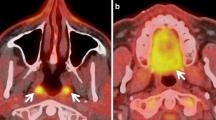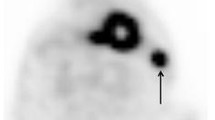Abstract
Purpose
The role of 2-deoxy-2-[F-18]fluoro-D-glucose-positron emission tomography (FDG-PET) was studied in a variety of cancers, including head and neck squamous cell carcinomas (HNSCC) and nasopharyngeal carcinomas (NPC), with several presentations indicating that for these clinical entities a “whole-body” (i.e., eyes to thighs) may yield little additional information. Therefore, we were prompted to review our experience with PET/computed tomography (CT) in the management of patients with HNSCC and NPC.
Materials and Methods
This is a retrospective study of 133 patients with HNSCC, 23-90 years old (average: 58.2 ± 12.7) and 26 patients with NPC, ages 16-75 (average: 47.3 ± 17.1), who had whole body PET/CT at our institution from Jan 2003 to Nov 2006. Reinterpretation of the imaging studies for accuracy and data analysis from medical records was performed. Lesions identified on PET/CT below the level of the adrenal glands were recorded and tabulated.
Results
Lesions were identified below the adrenal glands in seven patients (5.2%) with HNSCC. These included hepatic and osseous metastases from HNSCC in two patients (1.5%), a new renal cancer (0.75%), a new pancreatic cancer (0.75%), a new colon cancer (0.75%) and findings proven benign on follow-up (focal colon uptake in one patient and an inflammatory inguinal lymph node in another patient; 1.5%). Lesions were identified below the adrenal glands in three patients (11.5%) with NPC. These included osseous metastases from NPC in two patients (7.7%) and findings proven benign on follow-up (focal colon uptake in one patient; 3.84%).
Conclusion
This study suggests that whole body PET/CT imaging in HNSCC has a relatively low yield (3%, 95% CI: 1.33-8.42) of significant findings below the level of the adrenal glands. Therefore, implementing a more limited protocol (through the level of adrenal glands), especially in low-risk cases of HNSCC, may be considered. However, whole body PET/CT imaging in NPC may have a significant yield (7.7%, 95% CI: 1.02-25.26) of medically relevant findings below the level of the adrenal glands. Thus, the whole body (i.e., vertex to thighs) PET/CT scan of NPC patients appears to be the appropriate imaging protocol for this population. This recommendation requires further evaluation and validation in larger prospective studies.




Similar content being viewed by others
References
Jemal A, Siegel R, Ward E, Hao Y, Xu J, Thun MJ (2009) Cancer statistics, 2009. CA Cancer J Clin 59(4):225–249
Gambhir SS (2002) Molecular imaging of cancer with positron emission tomography. Nat Rev Cancer 2(9):683–693
Facey K, Bradbury I, Laking G, Payne E (2007) Overview of the clinical effectiveness of positron emission tomography imaging in selected cancers. Health Technol Assess 11(44):iii–iv, xi-267
Hillner BE, Siegel BA, Liu D et al (2008) Impact of positron emission tomography/computed tomography and positron emission tomography (PET) alone on expected management of patients with cancer: initial results from the National Oncologic PET Registry. J Clin Oncol 26(13):2155–2161
Zafra M, Ayala F, Gonzalez-Billalabeitia E et al (2008) Impact of whole-body (18)F-FDG PET on diagnostic and therapeutic management of medical oncology patients. Eur J Cancer 44(12):1678–1683
Zeitouni AG, Yamamoto YL, Black M, Gjedde A (1994) Functional imaging of head and neck tumors using positron emission tomography. J Otolaryngol 23(2):77–80
Agarwal V, BFt B, Johnson JT (2008) Indications for PET/CT in the head and neck. Otolaryngol Clin North Am 41(1):23–49, v
Senft A, de Bree R, Hoekstra OS et al (2008) Screening for distant metastases in head and neck cancer patients by chest CT or whole body FDG-PET: a prospective multicenter trial. Radiother Oncol 87(2):221–229
Kim SY, Roh JL, Yeo NK et al (2007) Combined 18F-fluorodeoxyglucose-positron emission tomography and computed tomography as a primary screening method for detecting second primary cancers and distant metastases in patients with head and neck cancer. Ann Oncol 18(10):1698–1703
Ishimori T, Patel PV, Wahl RL (2005) Detection of unexpected additional primary malignancies with PET/CT. J Nucl Med 46(5):752–757
King AD, Ma BB, Yau YY et al (2008) The impact of 18F-FDG PET/CT on assessment of nasopharyngeal carcinoma at diagnosis. Br J Radiol 81(964):291–298
Gil Z, Even-Sapir E, Margalit N, Fliss DM (2007) Integrated PET/CT system for staging and surveillance of skull base tumors. Head Neck 29(6):537–545
Kim MR, Roh JL, Kim JS et al (2007) Utility of (18)F-fluorodeoxyglucose positron emission tomography in the preoperative staging of squamous cell carcinoma of the oropharynx. Eur J Surg Oncol 33(5):633–638
Murakami R, Uozumi H, Hirai T et al (2007) Impact of FDG-PET/CT imaging on nodal staging for head-and-neck squamous cell carcinoma. Int J Radiat Oncol Biol Phys 68(2):377–382
Segall GM (2008) A new paradigm to increase utilization of PET/CT. J Nucl Med 49(6):53N–56N
Acknowledgment
This study was supported in part by grant NCI ICMIC P50 CA114747 (SSG).
Author information
Authors and Affiliations
Corresponding author
Rights and permissions
About this article
Cite this article
Iagaru, A., Mittra, E.S. & Gambhir, S.S. FDG-PET/CT in Cancers of the Head and Neck: What is the Definition of Whole Body Scanning?. Mol Imaging Biol 13, 362–367 (2011). https://doi.org/10.1007/s11307-010-0343-8
Published:
Issue Date:
DOI: https://doi.org/10.1007/s11307-010-0343-8




